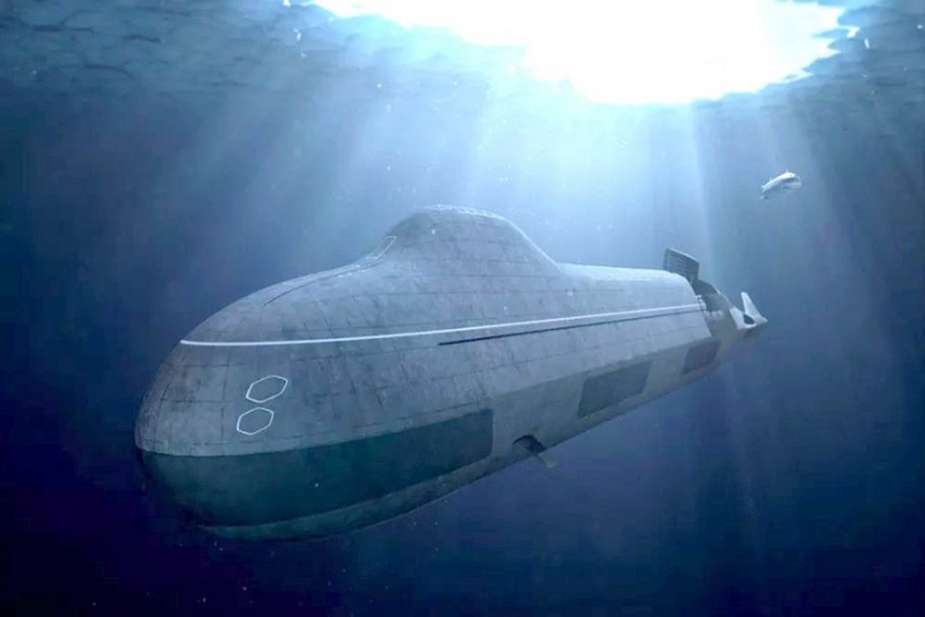Breaking news
Russia starts development of 5th-generation strategic submarine set to surpass Arcturus-class.
On March 31, 2024, Russia initiated the development of a fifth-generation, nuclear-powered ballistic missile submarine, according to a statement by Igor Vilnit, the General Director of the Rubin Design Bureau. This information was disclosed during an extended session of the Scientific Council of the Krylov State Research Center, an event that marked the 130th anniversary of the institution.
Follow Navy Recognition on Google News at this link
 The Arcturus class, presented in 2022, was intended as the next generation of Russian ballistic missile submarines (SSBNs), aiming to replace the existing Borei class by 2037 (Picture source: Rubin)
The Arcturus class, presented in 2022, was intended as the next generation of Russian ballistic missile submarines (SSBNs), aiming to replace the existing Borei class by 2037 (Picture source: Rubin)
General Director Vilnit, in conversation with Russian media, confirmed that the work on the new generation of strategic submarines has begun. However, details remain sparse; when queried about whether this development is related to the Arcturus-class submarine, Vilnit replied ambiguously, "It will be better," leaving the status and future of the Arcturus-class submarines unclear. It is interesting to note, however, that the Rubin Central Design Bureau for Maritime Engineering has a long history of submarine development, including the Typhoon class — the largest submarine ever built — and the Borei class, which alone replaced three previous classes of submarines active in the Russian Navy.
Vilnit also discussed the collaboration between the Central Design Bureau and the Krylov State Research Center, stressing the importance of transitioning from past projects to future plans. He pointed out the ongoing construction of serial ships and emphasized the necessity of initiating new projects promptly to keep pace with technological advancements in naval warfare.
He urged engagement in new projects to address emerging challenges, aiming to ensure that the submarine fleet remains a significant component of national defense. Vilnit's remarks suggest a focus on maintaining technological advancement to address potential threats.
The Arcturus class, presented by the Rubin Design Bureau at the Army-2022 exhibition, was intended as the next generation of Russian ballistic missile submarines (SSBNs), aiming to replace the existing Borei class by 2037. This model introduces an angled outer hull intended to reduce the sonar signature, a feature that aligns with contemporary submarine stealth technologies, including the application of anechoic coatings and vibration-isolating measures for machinery. The design indicates a 20% decrease in displacement compared to current models, plans for a crew complement of around 100, and a length of 134 meters. It is designed to carry 12 nuclear-armed intercontinental ballistic missiles, tailored for operations in Arctic conditions, reflecting a strategic move towards fewer but more advanced missiles.
The Arcturus class incorporates new elements such as the Surrogat-V autonomous underwater vehicle (AUV), designed for anti-submarine warfare, equipped with a sonar array, and a non-acoustic detection system known as SOKS, aimed at tracking submarines through chemical and radiation trails. The inclusion of AUVs indicates an expansion of the submarine's operational roles beyond traditional missile delivery. The design features a compartment for AUV launch and retrieval, suggesting an emphasis on versatility and reconnaissance capabilities within its strategic framework.
The Arcturus submarine is planned to incorporate a nuclear power plant, distinguishing it from traditional designs, as it is proposed to use a shaftless power system to potentially lower noise levels, a crucial aspect for submarines aimed at stealth, similar to the German Type-212CD and the British Dreadnought-class submarines. The propulsion system is intended to use two stern water jets housed within the submarine's structure. These jets, operated by drawing in water through openings on the sides and expelling it through rectangular nozzles, are designed with trapezoidal vertical planes to potentially enhance noise reduction efforts.
Despite the advanced features presented in the Arcturus class design, its construction prospects are uncertain, largely due to Russia's current economic conditions and historical delays in submarine production. The Rubin Design Bureau's design remains a proposal without official project sanctioning, reflecting potential trends in Russian naval design but not necessarily translating into immediate construction plans. Yet, the statements by Vilnit imply that the fifth-generation submarine project aims to surpass the initially outlined capabilities and specifications of the Arcturus class. Despite the lack of detailed information, this indicates an evolution in the strategic approach to Russia's submarine development programs to keep a leading position in terms of naval warfare.




























